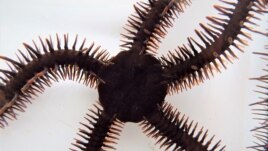08 January 2020
A relative of starfish does not have eyes, but can still see. That information comes from scientists who studied sea creatures in the coral reefs of the Caribbean and Gulf of Mexico.
The researchers reported this month that the starfish relative -- called the red brittle star -- is only the second creature known to be able to see without having eyes. This ability is called extraocular vision.

A red brittle star, Ophiocoma wendtii, is seen in this image released on January 2, 2020. (Lauren Sumner-Rooney/Handout via REUTERS.)
The other creature said to have extraocular vision is a kind of sea urchin.
Brittle stars, with five arms extending from a central disk, are part of a group of marine life called echinoderms. They have a nervous system but no brain.
The red brittle star measures up to about 35 centimeters wide, from the end of one arm to the other. It lives in bright and complex environments. Because of the possibility of being eaten by fish, the creature hides during daylight hours.
The red brittle star possesses extraocular vision as a result of light-sensing cells, called photoreceptors. These photoreceptors cover its body and chromatophores, the cells responsible for pigment or coloring.
During daytime, the chromatophores narrow the field of light being detected, making each photoreceptor like the pixel of a computer image. When combined with other pixels, the image becomes complete.
The visual system does not work at night, when the chromatophores contract in size.
Laboratory experiments suggested that the brittle stars have very simple vision. Placed in a circular environment, for example, they moved toward walls that were white with a black bar, suggestive of a daytime hiding place.
Lauren Sumner-Rooney is a research fellow at the Oxford University Museum of Natural History. She led the study, which appeared in the publication Current Biology.
"If our conclusions about the chromatophores are correct, this is a beautiful example of innovation in evolution," she said.
Sumner-Rooney added, "It's such an alien concept for us, as very visually driven animals, to conceive of how an animal might see its habitat without eyes, but now we know of two examples."
I'm John Russell.
Will Dunham reported on this story for Reuters. John Russell adapted it for VOA Learning English. George Grow was the editor.
________________________________________________________________
Words in This Story
coral reef – n. a rocky, underwater area formed by the growth of coral
extraocular – n. taking place outside the eye
species – n. a group of living organisms made up of similar individuals
detect – v. to identify or discover
pixel - n. any one of the very small dots that together form the picture on a television screen or computer monitor
contract – v. to decrease in size; shrink
innovation - n. the act or process of introducing new ideas, devices, or methods
evolution – n. the development of something, from a simple to a more complex form
conceive - v. to think of or create (something) in the mind
We want to hear from you. Write to us in the Comments Section.